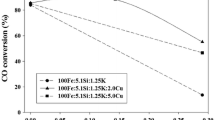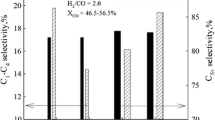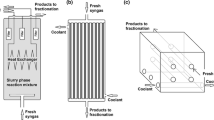Abstract
The effect of CO conversion on methane selectivity of a 10 % Co/TiO2 catalyst was investigated using a 1L continuously stirred tank reactor at 493–503 K, 2.4 MPa, H2/CO = 2 and GHSV = 0.4–6 Nl g −1cat h−1. The cobalt catalysts were activated by H2 and CO, respectively, in two separate runs. For the H2 activated catalyst, the methane selectivity decreased (15–6 %) and C5+ selectivity increased (80–91 %) linearly with increasing CO conversion from 10 to 60 %. The C2–C4 hydrocarbon selectivity decreased slightly with CO conversion. The enhancement in C5+ selectivity was mainly due to the decrease in methane selectivity. The CO activated cobalt catalyst was initially in a carburized form after activation, and then converted to a form with greater metallic character when exposed to syngas at Fischer–Tropsch conditions. The CO activated catalyst at pseudo steady-state had higher methane selectivity in general as compared to the H2 activated one, possibly due to the presence of the cobalt carbide phase. Two kinetic regions appear to exist for the CO activated catalyst. When CO conversion is lower than 20 %, the methane selectivity increased exponentially with CO conversion, which is attributed to enhanced hydrogenation. When CO conversion is higher than 20 %, the CO activated catalyst behaves more like a H2 activated catalyst, with a decrease in methane and an increase in C5+ selectivity with CO conversion.
Graphical Abstract









Similar content being viewed by others
References
Dry ME (2002) High quality diesel via the Fischer–Tropsch process—a review. J Chem Technol Biotechnol 77:43–50
Vannice MA (1975) The catalytic synthesis of hydrocarbons from H2CO mixtures over the group VIII metals: I. The specific activities and product distributions of supported metals. J Catal 37:449–461
Khodakov AY, Chu W, Fongarland P (2007) Advances in the development of novel cobalt Fischer–Tropsch catalysts for synthesis of long-chain hydrocarbons and clean fuels. Chem Rev 107:1692–1744
Iglesia E (1997) Design, synthesis, and use of cobalt-based Fischer–Tropsch synthesis catalysts. Appl Catal A 161:59–78
Iglesia E, Soled SL, Fiato RA, Via GH (1994) Dispersion, support, and bimetallic effects in Fischer–Tropsch synthesis on cobalt catalysts. Stud Surf Sci Catal 81:433–442
Khodakov AY, Griboval-Constant A, Bechara R, Zholobenko VL (2002) Pore size effects in Fischer–Tropsch synthesis over cobalt-supported mesoporous silicas. J Catal 206:230–241
Borg O, Eri S, Blekkan EA, Storsaeter S, Wigum H, Rytter E, Holmen A (2007) Fischer–Tropsch synthesis over gamma-calumina-supported cobalt catalysts: effect of support variables. J Catal 248:89–100
Bezemer GL, Bitter JH, Kuipers HPCE, Oosterbeek H, Holewijn JE, Xu X, Kapteijn F, Van Diilen AJ, De Jong KP (2006) Cobalt particle size effects in the Fischer–Tropsch reaction studied with carbon nanofiber supported catalysts. J Am Chem Soc 128:3956–3964
den Breejen JP, Radstake PB, Bezemer GL, Bitter JH, Frøseth V, Holmen A, Jong KPD (2009) On the origin of the cobalt particle size effects in Fischer–Tropsch catalysis. J Am Chem Soc 131:7197–7203
Prieto G, Martínez A, Concepción P, Moreno-Tost R (2009) Cobalt particle size effects in Fischer–Tropsch synthesis: structural and in situ spectroscopic characterisation on reverse micelle-synthesised Co/ITQ-2 model catalysts. J Catal 266:129–144
Yang J, Tveten EZ, Chen D, Holmen A (2010) Understanding the effect of cobalt particle size on Fischer–Tropsch Synthesis: surface species and mechanistic studies by SSITKA and kinetic isotope effect. Langmuir 26:16558–16567
Rane S, Borg Ø, Rytter E, Holmen A (2012) Relation between hydrocarbon selectivity and cobalt particle size for alumina supported cobalt Fischer–Tropsch catalysts. Appl Catal A 437–438:10–17
O’Brien RJ, Xu L, Spicer RL, Bao S, Milburn DR, Davis BH (1997) Activity and selectivity of precipitated iron Fischer–Tropsch catalysts. Catal Today 36:325–334
Ma W, Jacobs G, Ji Y, Bhatelia T, Bukur DB, Khalid S, Davis BH (2011) Fischer–Tropsch synthesis: influence of CO conversion on selectivities, H2/CO usage ratios, and catalyst stability for a Ru promoted Co/Al2O3 catalyst using a slurry phase reactor. Top Catal 54:757–767
Bukur DB, Pan Z, Ma W, Jacobs G, Davis BH (2012) Effect of CO conversion on the product distribution of a Co/Al2O3 Fischer–Tropsch synthesis catalyst using a fixed bed reactor. Catal Lett 142:1382–1387
Weller S, Hofer LJE, Anderson RB (1948) The role of bulk cobalt carbide in the Fischer–Tropsch synthesis1. J Am Chem Soc 70:799–801
Cheng J, Hu P, Ellis P, French S, Kelly G, Lok CM (2009) Density functional theory study of iron and cobalt carbides for Fischer–Tropsch synthesis. J Phys Chem C 114:1085–1093
Mohandas JC, Gnanamani MK, Jacobs G, Ma W-P, Ji Y–Y, Khalid S, Davis BH (2011) Fischer–Tropsch synthesis: characterization and reaction testing of cobalt carbide. ACS Catal. 1:1581–1588
Li J, Jacobs G, Das T, Davis BH (2002) Fischer–Tropsch synthesis: effect of water on the catalytic properties of a ruthenium promoted Co/TiO2 catalyst. Appl Catal A 233:255–262
Jacobs G, Ma W, Gao P, Todic B, Bhatelia T, Bukur DB, Khalid S, Davis BH (2012) Fischer–Tropsch synthesis: differences observed in local atomic structure and selectivity with Pd compared to typical promoters (Pt, Re, Ru) of Co/Al2O3 catalysts. Top Catal 55:811–817
Ressler T (1998) WinXAS: a program for X-ray absorption spectroscopy data analysis under MS-Windows. J Synchrotron Radiat 5:118–122
Shein IR, Medvedeva NI, Ivanovskii AL (2006) Electronic and structural properties of cementite-type M3X (M = Fe, Co., Ni; X = C or B) by first principles calculations. Phys B 371:126–132
Rehr JJ, Albers RC (2000) Theoretical approaches to x-ray absorption fine structure. Rev Mod Phys 72:621–654
Ravel B (2001) ATOMS: crystallography for the X-ray absorption spectroscopist. J Synchrotron Radiat 8:314–316
Newville M (2001) IFEFFIT: interactive XAFS analysis and FEFF fitting. J Synchrotron Radiat 8:322–324
Storsæter S, Borg Ø, Blekkan EA, Holmen A (2005) Study of the effect of water on Fischer–Tropsch synthesis over supported cobalt catalysts. J Catal 231:405–419
Iglesia E, Reyes SC, Madon RJ (1991) Transport-enhanced α-olefin readsorption pathways in Ru-catalyzed hydrocarbon synthesis. J Catal 129:238–256
Acknowledgments
The authors are very grateful for financial support from the Research Council of Norway. CAER researchers would like to thank the Commonwealth of Kentucky.We would also like to thank Dr. Syed Khalid and Dr. Nebojsa Marinkovic for assistance at Beamline X-18b. Use of the National Synchrotron Light Source, Brookhaven National Laboratory, was supported by the U.S. Department of Energy, Office of Science, Office of Basic Energy Sciences, under Contract No. DE-AC02-98CH10886.
Author information
Authors and Affiliations
Corresponding author
Rights and permissions
About this article
Cite this article
Yang, J., Jacobs, G., Jermwongratanachai, T. et al. Fischer–Tropsch Synthesis: Impact of H2 or CO Activation on Methane Selectivity. Catal Lett 144, 123–132 (2014). https://doi.org/10.1007/s10562-013-1099-y
Received:
Accepted:
Published:
Issue Date:
DOI: https://doi.org/10.1007/s10562-013-1099-y




